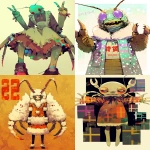Explore the Best AI Image Gallery

Beyond the Screen: Wearable Tech and the Future of Artistic Creation
The landscape of art and design is continuously evolving, pushed forward by technological advancements. Recently, wearable technology has emerged as a transformative force, redefining how artists create, interact with their work, and engage audiences. From immersive experiences to interactive installations, wearables are blurring the lines between the physical and digital realms, offering exciting new possibilities for artistic expression.
A Canvas on Your Body
Wearable technology provides a unique canvas for artists, allowing them to translate their ideas into tangible, embodied experiences. Imagine a suit that reacts to your movements, transforming patterns of light and color; or gloves that translate your hand gestures into digital sculptures. These are just glimpses into the potential of wearables in pushing the boundaries of artistic creation.
Interactive Installations
Wearable tech is revolutionizing interactive installations, enabling artists to create immersive environments where viewers become active participants. Imagine a gallery where visitors don headsets that respond to their presence, generating personalized soundscapes or visuals based on their movements and interactions with the space. This level of engagement transcends passive observation, inviting viewers to become integral parts of the artwork.
The Power of Presence
Beyond the visual, wearables can also enhance the emotional impact of art. By incorporating haptic feedback, for example, artists can create installations that evoke a sense of touch and physical presence. Imagine walking through an installation where your heartbeat triggers soundscapes or light patterns, creating a deeply personal and immersive experience.
Challenges and Considerations
As with any emerging technology, the integration of wearables into the creative industry presents both opportunities and challenges.
- Accessibility: Ensuring that wearable technology is accessible to a diverse range of artists and audiences, regardless of their technical skills or physical abilities, is crucial.
- Privacy: The use of wearable sensors raises concerns about data privacy and security. It is essential to establish clear guidelines and ethical frameworks for the collection, storage, and use of user data.
- Digital Divide: The cost of wearable technology can create a digital divide, potentially excluding certain communities from participating in this new creative landscape.
The Future of Wearable Creativity
Looking ahead, the potential of wearable tech in the creative industry is boundless. We can expect to see:
- More sophisticated sensors and haptic feedback: This will allow for even more immersive and interactive experiences.
- Integration with AI and machine learning: Wearables can learn from user interactions, adapting and evolving the artistic experience in real-time.
- Collaborative creative platforms: Artists can collaborate remotely using wearables, sharing ideas and building art together in shared virtual spaces.
Wearable technology is not just a tool for artists; its a catalyst for transformation. It empowers us to experience art in new ways, blurring the lines between creator and audience, and pushing the boundaries of what is possible in the world of creativity.






](https://images.ai-img.art/thumbnails/150/124afc0facac1c0c676099ab4d2aae88da73c9ba0b89d1f6de454d8b236458ef.webp)